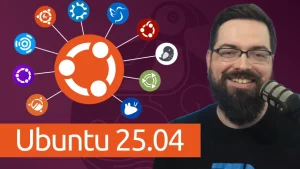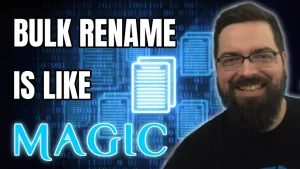Computer hardware is always getting faster and more powerful. With each new generation we get more cores, more bandwidth, and just… more power. The more powerful hardware gets the more power hungry it gets, that is the case. Thankfully researchers at the University of Waterloo found a way to cut datacenter power consumption by up to 30%!
Links:
- https://cs.uwaterloo.ca/news/cheriton-school-computer-science-researchers-update-linux
- https://git.kernel.org/pub/scm/linux/kernel/git/torvalds/linux.git/commit/?id=80b6f094756f
- https://www.theregister.com/2025/01/29/linux_kernel_tweak/
Support the channel by becoming a patron at https://tuxdigital.com/membership or get some swag at https://store.tuxdigital.com
Chapters:
00:00 Intro
00:30 Researchers discover a breakthrough
00:58 Let’s set the stage
01:55 What does the new code do?
02:35 How it works
03:27 Other benefits
03:57 The limitations
04:39 Software Inefficiencies vs More Powerful Hardware
05:11 There should be a news show covering this stuff…
Transcript
View full transcript
[0:00] Computer hardware is always getting faster and more powerful. With each new generation, we get more and more cores and more bandwidth and just more power. As the saying goes, with great power comes a huge amount of electricity needed to run it. Wait, that’s not the saying, is it? Well, the more powerful hardware it gets, the more power hungry it gets. That is true. Thankfully, researchers at the University of Waterloo found a way to cut data
[0:27] center power consumption by up to 30%. percent.
[0:31] Researchers at the Cheriton School of Computer Science at the University of Waterloo made this breakthrough discovery with just 30 lines of code. They were able to reduce data center power consumption by up to 30 percent. Now, this isn’t theoretical. This code was already submitted to the kernel and it is already published. That’s right. It’s in the Linux 6.13 kernel that was just released, and it kind of went under the radar. So I wanted to let people know about it because this is very cool information.
[0:57] And if you aren’t impressed by it already, let’s set the scene. The potential for this could have to cut environmental impact of datacenters is just massive. Imagine how much electricity it takes to power your home. Now step that up to how much it takes to power an office building. Now, how much it takes to power an absurdly large superstore like Walmart and whatever. And now crank that up a bit and think about the electricity it takes to power an entire city or a state or as much as your country would need. As you have all that in mind, which is a lot of electricity. The researchers of a University of the Waterloo say that the computing accounts like a computing in general accounts, as much as 5% of the entire world’s daily energy use. Now 5% doesn’t seem like a lot. But when you keep in mind, that’s in the entire world.
[1:48] That’s a lot. So with that in mind, saving up to 30% of power by datacenters is pretty good. So what do these 30 lines of code do? Well, the problem with traditional networking is that Linux network had been using the interrupt driven structure, meaning that the CPU stops tasks every time a new packet arrives. This is efficient for multi-user environments, but wastes resources in modern high throughput workloads like you would need in datacenters, For example, caching or reverse proxies and that sort of stuff.
[2:19] Here’s how Professor Martin Karsten of the Cheriton School of Computer Science puts it. He says that information arrives at datacenters in packets. Then the data center front end acts kind of like a receptionist at a front desk and figures out where to send those packets.
[2:35] Professor Karsten reached out to the Linux kernel developer and Fastly CTO Joe Damato to improve this concept and also implement it. And here’s how it works. So this adaptive polling solution, the old method basically is like the CPU constantly doing interrupt requests leading to inefficiencies. And the new method is a hybrid approach where it takes the network traffic when it’s high and it does CPU polls with data instead of waiting. And when the traffic is low, it reverts to the old interrupt based method. So to save power and it’s handled automatically in the kernel. This is the biggest deal right here is because these 30 lines of code is basically making it possible for datacenters to easily implement it and basically with zero effort as long as they turned it on they can have all this stuff done automatically
[3:24] thanks to the kernel update which is very cool.
[3:28] Now in addition to the 30 lower power consumption reducing like wasted cpu cycles there’s a lot of other stuff and a lot of other benefits up to 45 higher throughput without increasing latency for the workloads and also the biggest impact on network heavy applications like Memcached so it’s not going to cover everything but it’s going to make big impacts on certain types of applications and overall have a very beneficial thing through the networking.
[3:56] Now, there are some challenges and limitations here. It won’t benefit AI or HPC workloads because those use remote direct memory access (RDMA) instead of CPU-based networking. And enterprise long-term support kernels will take some time to adopt the patch. They may wait until a new version of the kernels are out for that are LTS associated, but also they may just like backport it, who knows. So it’ll take some time for that to be implemented. And of course, most datacenters are using enterprise distributions. So there may be like a little bit of a lag, but overall, the implications for this is just very massive, even without affecting the AI clusters.
[4:37] The implications are huge. And it also brings up the topic of software inefficiencies rather than just relying on hardware getting more and more powerful, because at some point we’re going to meet a threshold where hardware gains won’t be enough, so which do we do? Do we address software inefficiencies or make hardware more powerful?
[4:57] Well, I’m going to answer that question with another question. Why can’t we have both?
[5:04] Hopefully the people in charge of the datacenters take advantage of these gains for efficiency, but we’ll have to wait and see what happens.
[5:11] Now, the Linux kernel is a fascinating project, and so much has come from it. There should be really a weekly news show that you could subscribe to in order to keep up to date with what’s going on in the Linux and open source world. Oh, yeah, I made one of those. I started about eight years ago. Check out This Week in Linux. And if you want to learn more about all the cool stuff in the Linux 6.13 kernel, you can check out TWIL 294. And we also talked about some more cool stuff and the for the kernel release in my podcast Destination Linux in episode 404. so check those out.















Start the discussion at forum.tuxdigital.com